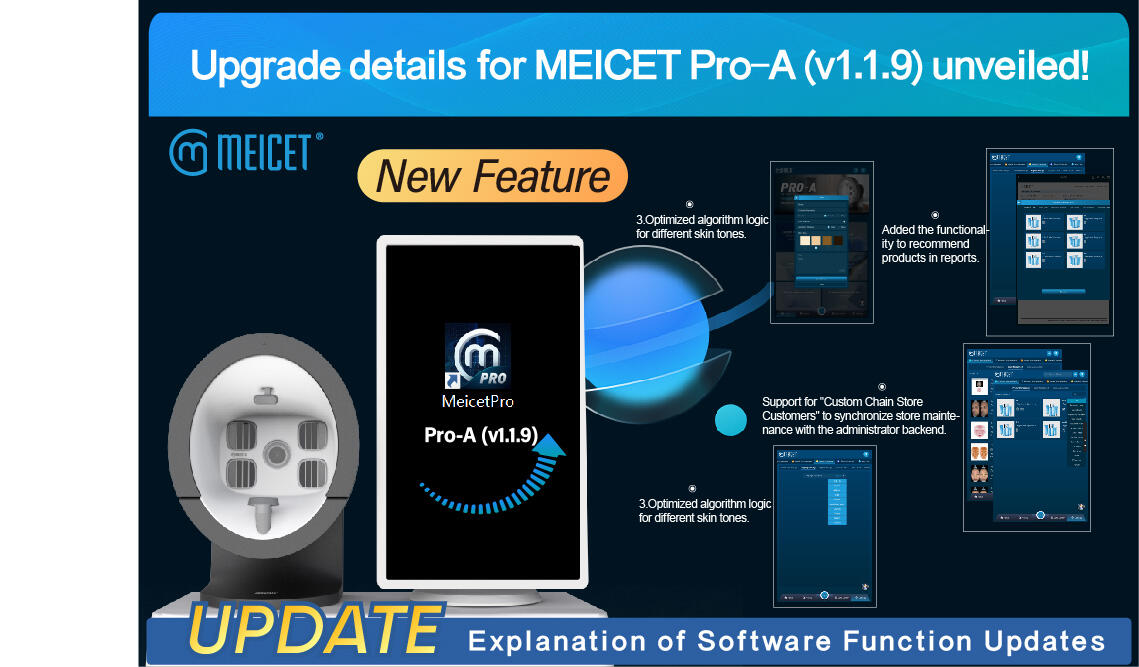
Pigmentation disorders—melasma, post-inflammatory hyperpigmentation (PIH), freckles, and solar lentigines—often present with similar dark spots, but their underlying causes and treatments vary dramatically. Misdiagnosis can lead to ineffective interventions or even worsening of the condition (e.g., using aggressive lasers on melasma, which may trigger further pigment production). MEICET’s Pro-A Skin Imaging Analyzer, with its multi-spectral imaging capabilities, eliminates this guesswork by distinguishing between epidermal and dermal pigment, revealing the true nature of the disorder and guiding targeted treatment.
Layered Pigment Analysis: Epidermis vs. Dermis
Pigmentation’s depth is the key to effective treatment: epidermal pigment (in the outermost skin layer) responds to topical brighteners and superficial peels, while dermal pigment (deeper in the skin) requires more aggressive interventions like fractional lasers. The Pro-A’s multi-spectral modes dissect this critical distinction:
- UV imaging highlights epidermal melanin, which fluoresces under ultraviolet light. Freckles, solar lentigines, and superficial PIH appear as bright, well-defined spots in UV mode—confirming they are amenable to treatments like vitamin C serums, tranexamic acid, or gentle chemical peels that target the epidermis.
- Cross-polarized light (CPL) imaging penetrates beyond the epidermis, revealing dermal pigment as gray-blue patches. This is characteristic of melasma, which often involves pigment migration into the dermis, and distinguishes it from PIH (which rarely extends beyond the epidermis). Dermal pigment also appears in some cases of post-laser hyperpigmentation, signaling deeper damage that requires careful laser settings to avoid exacerbation.
- RGB imaging provides context by mapping how surface pigment correlates with underlying layers. A patient with “dark spots” might have UV showing scattered epidermal PIH and CPL revealing no dermal involvement—ruling out melasma and simplifying treatment to topical exfoliants and sun protection.
Consider a patient with widespread facial pigmentation: UV scans show bright, superficial spots (likely lentigines), while CPL reveals faint gray-blue patches in the cheeks (suggesting concurrent melasma). This combination guides a two-phase plan: first, topical brighteners and low-fluence laser for the epidermal pigment, then fractional laser with conservative settings for the dermal melasma—avoiding over-treatment that could trigger inflammation and more pigment production.
Characterizing Pigmentation Patterns
Beyond depth, pigmentation disorders have distinct patterns that multi-spectral imaging can identify:
- Melasma often appears as symmetric, irregular patches on the cheeks, forehead, or upper lip—visible in CPL mode as diffuse dermal pigment with occasional epidermal overlay. This pattern, combined with a history of hormonal triggers (e.g., pregnancy, oral contraceptives), confirms the diagnosis and steers clinicians toward treatments that address both layers (e.g., hydroquinone for the epidermis, low-energy lasers for the dermis).
- PIH typically follows inflammation (acne, eczema, or trauma) and appears as localized spots corresponding to the original lesion. In UV mode, PIH shows sharp borders and fades over time, distinguishing it from melasma’s persistent, widespread pattern.
- Solar lentigines (age spots) appear in sun-exposed areas (cheeks, hands, forehead) and show consistent brightness in UV mode, with clear borders and no dermal involvement—responding well to targeted laser treatments.
By correlating these patterns with clinical history, the Pro-A enables precise diagnosis. For example, a patient with a history of acne and new “dark spots” in the jawline would have UV scans showing PIH (sharply defined, matching previous acne sites), ruling out melasma and guiding treatment to exfoliants that speed epidermal turnover.
Monitoring Treatment Response
Pigmentation treatments often take weeks to months to show results, and subtle changes can be hard to detect with the naked eye. The Pro-A’s before-and-after comparison tools quantify progress:
- UV fluorescence intensity tracks epidermal pigment reduction. A patient using a tranexamic acid serum for PIH can have their progress measured by decreased brightness in UV mode, confirming the treatment is working even before visible light changes.
- CPL gray-blue density monitors dermal pigment response to laser therapy. Melasma patients undergoing fractional laser treatments will show reduced density in CPL scans over time, guiding clinicians to continue or adjust sessions based on objective data.
- RGB color uniformity assesses overall tone improvement, ensuring treatments are achieving not just spot reduction, but a more balanced complexion.
This data prevents premature abandonment of effective treatments or unnecessary continuation of ineffective ones. A patient with melasma might see minimal visible change after two laser sessions, but CPL scans showing 20% reduced dermal pigment density justify continuing the plan—avoiding the frustration of “no results” and ensuring long-term success.
Guiding Sun Protection and Prevention
All pigmentation disorders are exacerbated by UV exposure, but the Pro-A’s imaging reinforces the importance of sun protection by making UV damage visible:
- UV scans reveal latent pigment activation in areas that appear normal in visible light, showing patients how unprotected sun exposure is already affecting their skin.
- For melasma patients, CPL scans taken after sun exposure may show increased dermal pigment density, reinforcing the need for strict sun protection (broad-spectrum sunscreen, hats, avoidance of peak UV hours).
This visual evidence is far more compelling than generic advice, increasing patient adherence to preventive measures—a critical component of long-term pigmentation management.
The Pro-A Skin Imaging Analyzer transforms pigmentation diagnosis and treatment from guesswork to precision. By distinguishing between epidermal and dermal pigment, characterizing patterns, and monitoring progress, it ensures clinicians target the right disorder with the right intervention—delivering clearer, more even skin with fewer setbacks.
 EN
EN
 AR
AR
 BG
BG
 HR
HR
 CS
CS
 DA
DA
 NL
NL
 FI
FI
 FR
FR
 DE
DE
 EL
EL
 HI
HI
 IT
IT
 JA
JA
 KO
KO
 NO
NO
 PL
PL
 PT
PT
 RO
RO
 RU
RU
 ES
ES
 SV
SV
 TL
TL
 IW
IW
 ID
ID
 SR
SR
 SK
SK
 SL
SL
 UK
UK
 VI
VI
 SQ
SQ
 HU
HU
 TH
TH
 TR
TR
 FA
FA
 AF
AF
 MS
MS
 UR
UR
 BN
BN
 LA
LA

